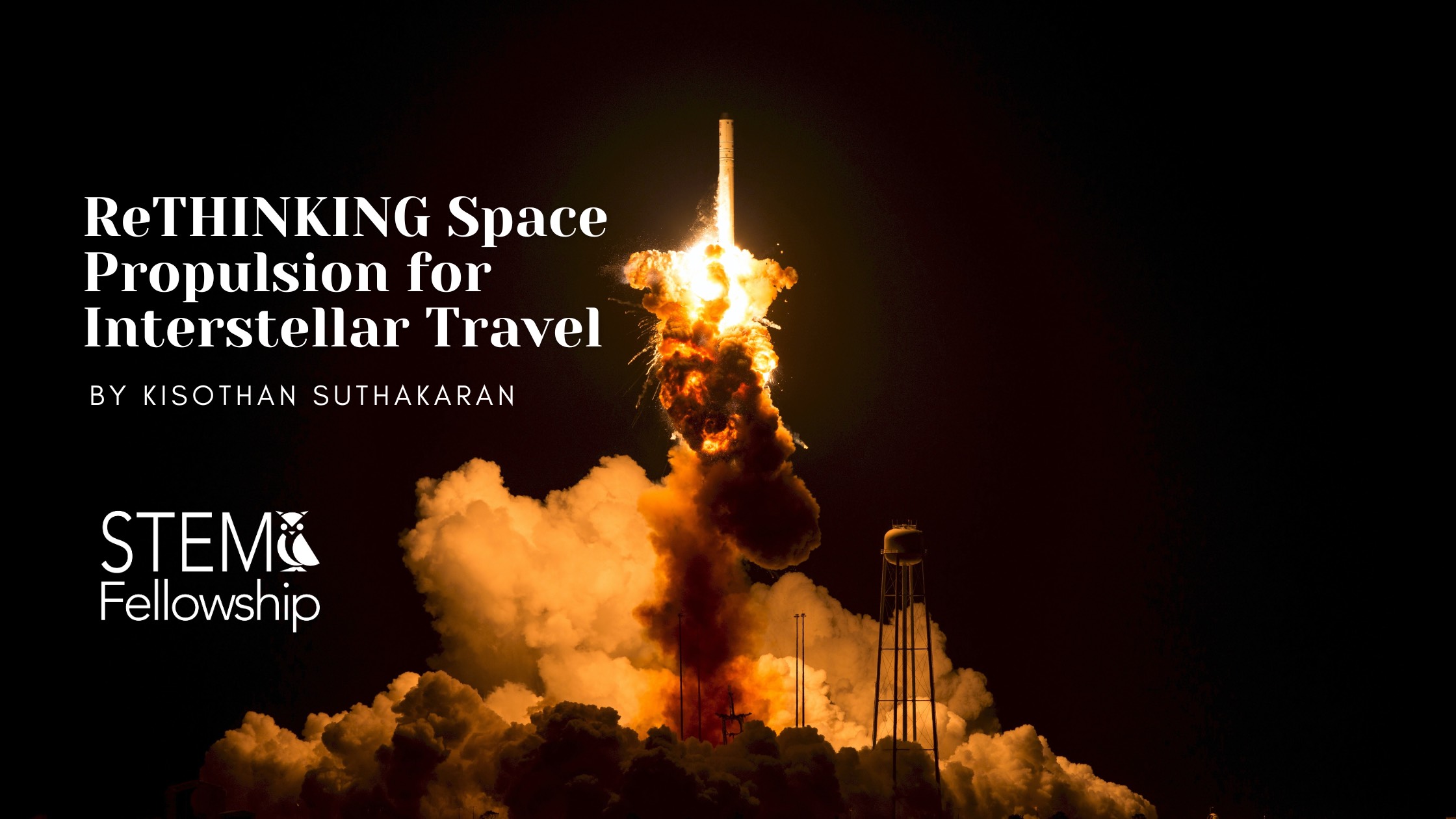By Kisothan Suthakaran
In 2016, astronomers discovered an Earth-like planet orbiting Proxima Centauri, our nearest-known star, situated such that its temperature allows liquid water to possibly exist on its surface. Our current knowledge about this exoplanet is however limited by the data provided by telescopes and spectrographs. The only effective way of gaining more insights about this exoplanet is to get there, either physically or remotely. The underlying issue is that our closest star system is 4.25 light-years away from the sun. To reach this destination promptly without running out of fuel, space propulsion must be rethought and revitalized because current technology is inadequate for long-distance spaceflight. This article will discuss the three most promising propulsion schemes for efficient short-term interstellar flight currently in development: ion thrusters, fusion-driven rockets, and laser-pushed light sail.
Tyranny of the Rocket Equation
Conventional rocket engines, which use the exhaust gas from the combustion reaction to propel the spacecraft as depicted in Figure 1, generate high thrust but consume a large amount of fuel in a short period.

Figure 1: Chemical Rocket Engine Schematic (Source: EFDA)
This type of rocket is best suited to lift off the ground and reach low Earth orbit. For long-distance spaceflight, the Tsiolkovskjy rocket equation (1), which governs the motion of all rockets, becomes a major concern (1).
v = ve In m0mf (1)
This equation relates the velocity gain of vehicle, v, to the exhaust velocity, ve, of the reaction mass and the ratio of the initial mass of the rocket, m0, to its final mass, mf. The plot of this equation in Figure 2 shows that as the desired momentum change v increases, the required amount of fuel increases exponentially.

Figure 2: Plot of the Rocket Equation
On the other hand, trading velocity gain for lower fuel consumption results in longer flight durations. This dilemma between fuel consumption and flight time puts interstellar travel in a problematic situation. The propulsion solutions presented below seek to overcome this obstacle by either pushing the practical limits of the rocket equation or simply circumventing it.
Potential Propulsion Technologies
Ion Thruster
An ion thruster is a form of electric propulsion that relies on injecting charged particles into an electric field to accelerate them. The resulting force propels the spacecraft using Newton’s third law. This is still a rocket concept, but instead of ejecting high-temperature combustion products, ions are discharged. This has a significant impact on the fuel consumption of this propulsion system, making it more efficient than combustion engines (2). The anatomy of the ion engine is illustrated in Figure 3.

Figure 3: Electrostatic Ion Thruster Diagram (Source: NASA)
Fusion-Driven Rocket
The fusion-driven rocket scheme attempts to exploit the tremendous amount of nuclear energy released by atomic synthesis to either directly expel hot plasma or heat and accelerate a propellant. The physics of fusion is governed by Einstein’s mass-energy equivalence equation (2).
E = mc² (2)
When two atoms collide and fuse, the resulting reaction produces a new atom and the mass difference m between the reactants and the products are converted to energy, E, as shown in Figure 4. This equation states that the conversion factor between mass and energy is the square of the speed of light c, which is about 300 000 km/s. The large value for c is the reason behind the enormous amount of energy that is released from these collisions (3).

Figure 4: Schematic of the Fusion Reaction (Source: EFDA)
Laser-Pushed Lightsail
Unlike electric and nuclear propulsion, the laser-pushed light sail is a propellantless scheme that relies on the principle of direct momentum transfer. The energy source is a stationary laser that sends a large light beam from Earth to a thin sheet of material moving in space called a light sail, which carries the probe (4). Although the momentum equation (3) from classical physics suggests that massless objects like photons can’t carry momentum, the laws of quantum mechanics and special relativity allow any particle that carries energy to have momentum, regardless of whether they have mass or not, as demonstrated in the general form of the relativistic equation (4). In the quantum world, all wave-like particles have energy since they have a non-zero frequency as shown by Plank’s equation (5).
p = mv (3)
p = E2 – (mc2)2(c2) (4)
E = hf (5)
Hence, as illustrated in Figure 5, the momentum carried by the photons can be transferred to the sail throughout the interstellar journey. This simple solution allows for high-velocity missions without the limitation of the rocket equation.

Figure 5: Schematic of the Laser Propulsion Concept [5]
Efficiency and Technical Feasibility
An ion thruster is a low-thrust engine that builds up momentum with time. This means that this rocket starts with a low propulsive force and reaches the optimal thrust for interstellar travel only later on in the journey. On the other hand, ion thrusters expel ions at a faster rate than at which chemical rockets expel reaction mass. As shown in equation (6), this high exhaust velocity, Ve, provides ion rockets with greater specific impulse ISP than combustion engines, which implies that they burn their fuel much more efficiently than their traditional counterparts.
Isp= Ve (g) (6)
This combination of low thrust and high specific impulse allows these rockets to sustain long-distance spaceflight, but the associated long-duration flight times are inconvenient for short-term interstellar missions. That being said, the ion propulsion scheme is the most feasible solution among the three candidates as it has already been implemented and heavily tested. Figure 6 shows a prototype ion thruster built by NASA in 2005.

Figure 6: Ion Engine Testing at NASA (Source: NASA)
The testing results confirm the low propulsive force of the engine. The current research on ionic propulsion is more geared towards using ion thrusters for low-thrust orbital maneuvers than for high-thrust deep space missions because there is a theoretical limitation on the amount of propulsive force that can be achieved by these engines. Child-Langmuir’s law, illustrated by equation (7), stipulates that there is a fundamental limit to the amount of charge that can be contained in space.
J = K Vd (d2) (7)
This equation provides the maximum current density J between two infinite parallel electrodes separated by a distance d with a potential difference of Vd. K, is a physical constant. Since the current density is closely related to the intensity of the electric field, there is a limit to how rapidly ions can be ejected out of the rocket. Thus, although ion engines are feasible, they are limited in thrust.
The fusion-driven rocket is the most powerful jet propulsion concept. The relativistic energy emerging from the fusion reaction provides these rockets with a great amount of thrust. Research has shown that a fusion core that uses hot plasma exhaust to produce thrust could enable rockets to reach ‘‘several hundred times higher exhaust velocities than today’s high power chemical rocket engines.’’ [6] The most attractive feature of fusion rocket engines is that their high thrust capacity is coupled with high specific impulse as opposed to ion thrusters and chemical rockets, which exhibit a tradeoff between thrust and fuel efficiency. For this reason, fusion rockets are often considered the ideal technology for interstellar propulsion. However, implementing this solution is limited by some intricate engineering challenges that are far from being solved. The biggest one of them is the problem of controlling fusion inside a rocket. Scientists and engineers have made some significant progress in controlling fusion on Earth through various schemes. Figure 7 shows one of them, where a magnetic field generated by the flow of current in the coils forces hot plasma to swirl within the torus shape vessel (7).


Figure 7: Small Scale (Top) and Large Scale (Bottom) View of the Magnetic Confinement of Plasma in the Tokamak Fusion Reactor (Source: Fusion for Energy and JET/UKAEA)
However, current technology could only barely confine this highly conductive ionized substance and is unable to harness the energy from the reaction for any practical use. Even if such a feat is accomplished, the concept of installing a fusion reactor inside a rocket raises another concern. The compactness of the reactor is critical to the rocket’s thrust-to-weight ratio, which determines its overall performance. Considering that the most compact fusion reactor built on Earth weighs about 200 metric tons, minimizing the weight and the size of nuclear engines remains a challenging task. In short, fusion has a long way to go before it can be used to power rockets.
The laser-pushed light sail is a high thrust scheme that relies on the cumulative force exerted by the photons bouncing off the sail to propel the spacecraft. Due to the absence of propellant, the notions of specific impulse and fuel consumption are meaningless in this context. The overall efficiency of this scheme can be assessed by examining the net acceleration of the sail and the corresponding flight duration. A detailed study conducted at Hughes Research Laboratory in California reveals that a light sail accelerated at 0.36 m/s2 by a 65 GW laser setup would reach the exoplanet near Centauri within 40 years (8). This amounts to 360 N of thrust. For comparison, the highest level of thrust achieved by an ion engine is 5.4 N. Hence, a light sail surpasses an ion thruster in thrust and speed. Moreover, since the laser propulsion scheme is based on known physics and technology, the engineering challenges involved in the execution of this concept are less complex than the technological limitations of fusion-powered rockets. For instance, one of the major concerns of photonic propulsion is to maximize the reflectivity of the light sail and minimize its absorbance. As depicted in Figure 8, the underlying reason is that a reflected photon transfers two impulses to the sail whereas an absorbed photon gets only one chance to give away its momentum (9).

Figure 8: Momentum Transfer During (a) Absorption (b) Reflection [8]
As a result, these factors, together with the temperature limitations of the light sail, play a critical role in the thickness of the sail and the material selection. Aluminum shows promise due to its desirable melting temperature, tensile strength, and reflectivity. Using a transparent dielectric material instead of a metal film is also a prominent solution since it allows for high reflectance over a wide range of wavelengths. Another important engineering concern of this propulsion scheme is the inverse square law of the intensity of light shown by the mathematical relation (7).
I = d2 (7)
The light intensity, I, decreases with the square of the distance, d, which means that it gets harder to focus the beam light energy onto the sail as it moves away from the Earth. Some potential ideas to overcome this challenge is to decrease the wavelength of the laser to reduce the beam spread or use larger sails to increase the surface area. The narrow focus of these problems and the wide range of solutions indicate that these issues are within the scope of current technology and knowledge and hence are likely to be solved shortly.
Conclusion
The laser-pushed light sail scheme turns out to be the most viable solution for short-term interstellar flight. While the ion thruster provides great fuel efficiency and is the most feasible solution, it cannot reach the desired destination in a reasonable time interval due to its low-thrust performance. On the other hand, despite their great efficiency, fusion-driven rockets are an unrealistic concept, considering the current technological limitations of fusion control and confinement. The laser propulsion solution strikes the right balance between efficiency and feasibility.
Sources:
[1] A Novel Approach for Optimization of Nozzle Angle and Thrust Vectoring Controller via a Sub-Mutation Genetic Algorithm – Scientific Figure on ResearchGate. Available from: https://www.researchgate.net/figure/The-parts-of-liquid-rocket-engine_fig1_320628712 [accessed 12 Jun, 2022]
[2] L. C. David, J. T. Varghese and S. R. Nadarajan Assari Syamala, “Ion Propulsion Technology: NASA’s Evolutionary Xenon Thruster (NEXT) Development and Long Duration Tests Results and its Applications,” 2020 Advances in Science and Engineering Technology International Conferences (ASET), 2020, pp. 1-5, doi: 10.1109/ASET48392.2020.9118370.
[3] W. Lockett. “The Fusion Rocket That Could Dominate Interplanetary Travel” Medium. https://medium.com/predict/the-fusion-rocket-that-could-dominate-interplanetary-travel-d4a8234c67cd (accessed May. 27, 2022)
[4] G. Landis, “Advanced Solar and Laser-Pushed LightSail Concepts,” NASA Institute for Advanced Concepts., Los Angeles, CA, USA,Tech. Rep. TR-0200 (4230-46)-3, Nov. 1999.
[5] Landis, G.A. (1999). Advanced Solar-and Laser-pushed Lightsail Concepts Final Report.
[6] Wurden, G.A., Weber, T.E., Turchi, P.J. et al. A New Vision for Fusion Energy Research: Fusion Rocket Engines for Planetary Defense. J Fusion Energy 35, 123–133 (2016). https://doi.org/10.1007/s10894-015-0034-1
[7] T. Kammash and D. L. Galbraith, “A novel fusion approach to space power and propulsion,” Proceedings of the 24th Intersociety Energy Conversion Engineering Conference, 1989, pp. 2531-2534 vol.5, doi: 10.1109/IECEC.1989.74830.
[8] Forward, R.L. (1984) Roundtrip interstellar travel using laser-pushed lightsails. Journal of Spacecraft, 21, 187- 195. doi:10.2514/3.8632
[9] T. Pultarova, “Ion thruster prototype breaks records in tests, could send humans to Mars,” Space.com, 13-Oct-2017. [Online]. Available :https://www.space.com/38444-mars-thruster-de sign-breaks-records.html#:~:text=%22It%20operated%20at%20a%20huge,at%20the%20University%20of%20Michigan. [Accessed: 13-Jun-2022].
About The Author:

Kisothan Suthakaran is a 3rd-year mechanical engineering student at McGill University with a keen passion for aerospace engineering & modern physics. He is particularly fascinated by rockets, aircrafts & black holes. He likes to work on innovative solutions for challenges in space exploration and ponder deep questions about our Universe.
Contact Kisothan:
Email: kisothan.suthakaran@mail.






